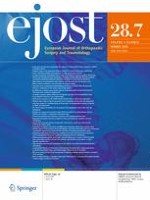Erschienen in:

07.05.2018 | Original Article • HIP - ARTHROPLASTY
High incidence of intraoperative calcar fractures with the cementless CLS Spotorno stem
verfasst von:
Carla Timmer, Davey M. J. M. Gerhardt, Enrico de Visser, Marinus de Kleuver, Job L. C. van Susante
Erschienen in:
European Journal of Orthopaedic Surgery & Traumatology
|
Ausgabe 7/2018
Einloggen, um Zugang zu erhalten
Abstract
Introduction
This study reports on the incidence of intraoperative calcar fractures with the cementless Spotorno (CLS) stem, and the potential role of a learning curve and implant positioning is investigated.
Methods
After introduction of the CLS stem, 800 consecutive cementless total hip arthroplasties (THA) were analyzed. The incidence of calcar fracture in the first 400 THA was compared with the second 400 THA, in order to study a potential learning curve effect. According to the instruction for users, varus positioning of the stem was avoided and a femoral neck osteotomy was aimed relatively close to the lesser trochanter since these are assumed to be correlated with calcar fractures. Implant positioning (neck-shaft angle, femoral offset and osteotomy-lesser trochanter distance) was measured on postoperative pelvic radiographs of all THA with calcar fractures and 100 randomly selected uncomplicated control cases.
Results
Seventeen (2.1%) intraoperative calcar fractures were recorded. The incidence of calcar fracture differed between the first 400 THA (n = 11) and the second 400 THA (n = 6). This difference was not statistically significant (p = 0.220); however, these numbers indicate a trend toward a learning effect. No significant difference in stem positioning nor the height of the femoral neck osteotomy was measured between THA with a calcar fracture (n = 17) and the control cases (n = 100).
Conclusions
We report on a high incidence of intraoperative calcar fractures with the use of a CLS stem. The risk for calcar fractures remains clinically significant even after adequate implant positioning in the hands of experienced hip surgeons. Surgeons should be aware of this implant related phenomenon and be alert on this phenomenon intraoperatively.











